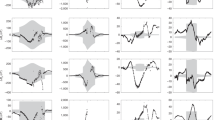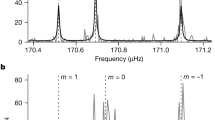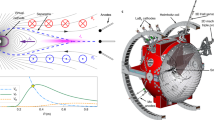Abstract
An axisymmetric octupole model of Saturn's planetary magnetic field is proposed here. This three parameter model, characterized by the Schmidt-normalized spherical harmonic coefficients g01 = 21,535 nT, g02 = 1,642 nT and g03 = 2,743 nT, is extremely efficient in representing the main magnetic field of Saturn and reconciling the in situ magnetic field observations obtained by Pioneer 11 with those obtained by the Voyager 1 and 2 spacecraft. Saturn's unique magnetic field configuration is thus not that of a simple displaced dipole but rather appears to be the axisymmetric part of a complex dynamo field. This result is consistent with Stevenson's model of the interior of Saturn1, in which the differential rotation of a metallic fluid shell above the active dynamo region attenuates all non-axisymmetric components of the dynamo field.
This is a preview of subscription content, access via your institution
Access options
Subscribe to this journal
Receive 51 print issues and online access
$199.00 per year
only $3.90 per issue
Buy this article
- Purchase on Springer Link
- Instant access to full article PDF
Prices may be subject to local taxes which are calculated during checkout
Similar content being viewed by others
References
Stevenson, D. J. Science 208, 746–749 (1980).
Smith, E. J. et al. Science 207, 407–410 (1980).
Acun̄a, M. H. & Ness, N. F. Science 207, 444–446 (1980).
Smith, E. J. et al. J. geophys. Res. 85, 5655–5674 (1980).
Acun̄a, M. H. et al. J. geophys. Res. 85, 5675–5678 (1980).
Ness, N. F. et al. Science 212, 211–217 (1981).
Acun̄a, M. H. et al. Nature 292, 721–724 (1981).
Ness, N. F. et al. Science 215, 558–563 (1982).
Chapman, S. J. & Bartels, J. Geomagnetism (Oxford University Press, 1940).
Connerney, J. E. P. et al. Nature 292, 724–726 (1981).
Connerney, J. E. P. J. geophys. Res. 86, 7679–7693 (1981).
Simpson, J. A. et al. J. geophys. Res. 85, 5731–5762 (1980).
Vogt, R. E. et al. Science 215, 577–582 (1982).
Lawson, C. L. & Hanson, R. J. Solving Least Squares Problems (Prentice-Hall, New Jersey, 1974).
Connerney, J. E. P. et al. J. geophys. Res. 86, 3623–3627 (1982).
Langel, R. A. et al. Geophys. Res. Lett. 7, 793–796 (1980).
Cowling, T. G. Mon. Not. R. astr. Soc. 94, 39–48 (1934).
Hide, R. Nature 293, 728–729 (1981).
Kaiser, M. L. & Desch, M. D. J. geophys. Res. (in the press).
Author information
Authors and Affiliations
Rights and permissions
About this article
Cite this article
Connerney, J., Ness, N. & Acuña, M. Zonal harmonic model of Saturn's magnetic field from Voyager 1 and 2 observations. Nature 298, 44–46 (1982). https://doi.org/10.1038/298044a0
Received:
Accepted:
Issue Date:
DOI: https://doi.org/10.1038/298044a0
This article is cited by
-
Strong whistler mode waves observed in the vicinity of Jupiter’s moons
Nature Communications (2018)
-
Three eras of planetary exploration
Nature Astronomy (2017)
-
Saturn's ring rain
Nature (2013)
-
Mapping Magnetospheric Equatorial Regions at Saturn from Cassini Prime Mission Observations
Space Science Reviews (2011)
-
Space Exploration of Planetary Magnetism
Space Science Reviews (2010)
Comments
By submitting a comment you agree to abide by our Terms and Community Guidelines. If you find something abusive or that does not comply with our terms or guidelines please flag it as inappropriate.



